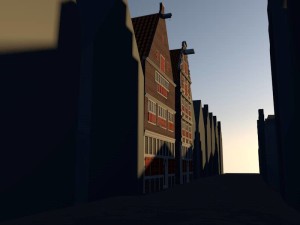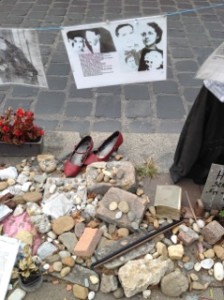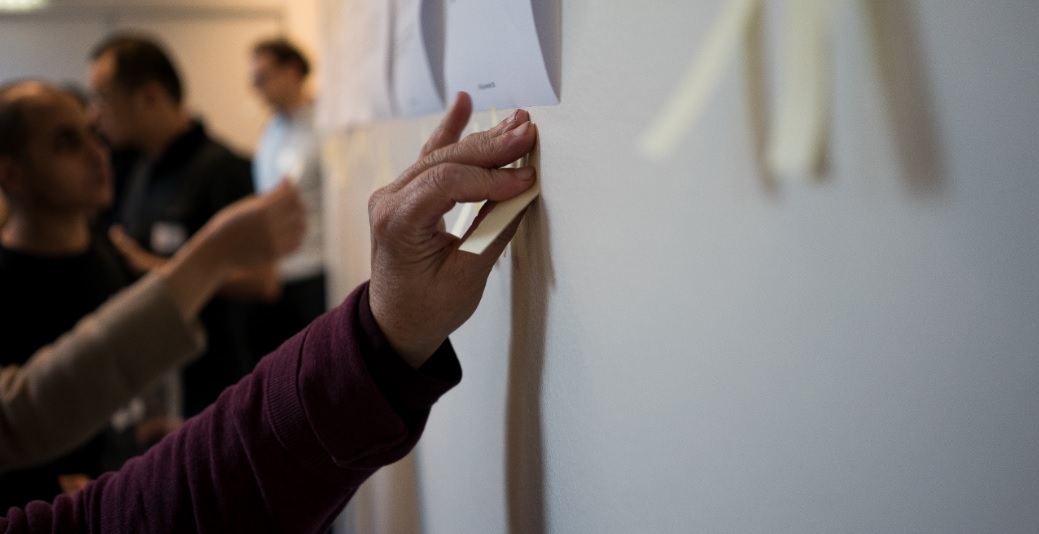Proposal for a Play session: Creating a basis for historical GIS research in Amsterdam
In this session we would like to set up a basic GIS of Amsterdam together, in order for historians to have a basic GIS with commonly used data available as a basis for spatial research. We have a few spatial data sets available (cinemas, shops, theatres from the last few centuries and some maps), but you’re welcome to bring your own of course. Those unfamiliar with GIS applications can set up the easier data sets while those experienced in working with spatial data can import the more difficult data sets.
Proposal for a Teach and Talk session: The creation of 3/4D models as integral part of historical research.
Loes Opgenhaffen (UVA) & Madelon Simons (UVA)
 Like archaeologists, with whom in the last two decades or so 3D modelling became more embedded in research, arthistorians and historians could benefit too by integrating innovative 3D technology in their research, since it may be a valuable visual and contextual aid in the interpretative process. In several courses and tutorials we tested how these models were made and used by students in arthistory. During these classes we learned that working with 3D modelling as part of research changes the way how arthistorical teaching should be guided and discussed, and more importantly, by whom. Simple 3D tools such as SketchUp will suffice in the initial process, but what if students need support from more professional software (and subsequent hardware) and specialists, and who should these specialists be (arthistorical 3D visualisers, or 3D visualisers specialised in arthistory?)? What does thinking in 3- or 4- dimensions add to our understanding of historical processes and image of the past? During the session we show all kind of examples and hope for innovative insights, suggestions and feedback.
Like archaeologists, with whom in the last two decades or so 3D modelling became more embedded in research, arthistorians and historians could benefit too by integrating innovative 3D technology in their research, since it may be a valuable visual and contextual aid in the interpretative process. In several courses and tutorials we tested how these models were made and used by students in arthistory. During these classes we learned that working with 3D modelling as part of research changes the way how arthistorical teaching should be guided and discussed, and more importantly, by whom. Simple 3D tools such as SketchUp will suffice in the initial process, but what if students need support from more professional software (and subsequent hardware) and specialists, and who should these specialists be (arthistorical 3D visualisers, or 3D visualisers specialised in arthistory?)? What does thinking in 3- or 4- dimensions add to our understanding of historical processes and image of the past? During the session we show all kind of examples and hope for innovative insights, suggestions and feedback.
Proposal for talk session: How to teach artistic digital thought in Age 2.0
I’d like to share and discuss the follow didactic method we have been operating for some years now.
There are many ways to teach art in the Academies, it depends on the goal to be achieved. In the course of New Technologies of Art and New Media Art, a 3+2 degree at the Accademia di Belle Arti of Naples – Italy, we train young artists that shall work in smart cities and across digital interactive scenarios.
Our learning activity, fairly innovative in Italy, is based on a daily lab life and almost without frontal lessons; all disciplines are merged and teachers and classrooms work on different projects mixed into a single-flow. Our keywords are relationship, interaction, contamination, cross-over between disciplines, teamwork. Furthermore we consider the error as an essential and vital part of the grieving process.
Over five years students grow by expressing, sharing, debating and questioning their ideas and putting them in practice through a spontaneous creation of a network, exactly like it occurs in the Web.
In order to educate the students on digital and connective thought, theory and practice go together throughout the program of study.
Periodical tests in the form of pitch are carried out in the Lab, while more complex artistic projects are often exposed outside of Academy.
This didactic method is frequently applied also for the thesis. For example, in this discussion we’ll show the interactive sculpture Ch’i – Respiro Cosmico (Cosmic Breath), a graduate thesis realized by a collective of grad students in collaboration with many other colleagues of the Lab and recently exposed in Maker Faire Rome.
Ch’i is an Oriental style dragon, bearer of positivity, wisdom and light, and its poetic represents the reincarnation of Yang. However, because an artist is a visionary, he knows that Yang is only a part of the whole. Thus, the creative process must also reveal Yin, a dark side of the life here summarized in a global crisis, at its peak with the migrant’s apocalypse.
The razzle-dazzle dragon sculpture bears a new life, but to do this it needs to be balanced with Yin.
So, Ch’i has an audible breath, a heart visible under the form of a pulsing light and is connected to the Web by the #migrant. When the #migrant flow increases, a sudden shortness of breath occurs while the heart rate rises. When the flow decreases, the whole pulse slows.
Ch’i – Respiro Cosmico, is a receptor of deeper mining and a vehicle of energies. It increases the awareness we live in a shared world.
Proposal for a Talk Session: DH and Libraries
Proposal for a Talk (and Discuss) Session: Digital Humanities and Libraries
Michiel Cock (VU) & Steven Claeyssens (KB)
We believe that research libraries can play a pivotal role in the uptake of Digital Humanities research and teaching, but would like to ask the campers for advice. Inspired by some international examples, we are working on a first Dutch program for our fellow librarians to familiarize them with Digital Humanities methods, tools and ideas. We would love to have your input and feedback. What kind of expertise do you, as a researcher, expect from your librarian? What would your (Ph.D) students need? What knowledge do you, as a librarian, lack to feel comfortable as a full partner in a DH project?
We propose a session to discuss these questions and gather ideas for our program.
Proposal for Talk Session: Back to the Hyper-Web: Ted Nelson’s Dream Machine/Comp Lib Revisited
In 1965, Ted Nelson proposed a very radical way of using computers. He suggested that they were, already, more powerful as media machines, worked on by everyone, for personal uses. The original paper didn’t get much interest, but when Nelson published his dual-book, Comp Lib/Dream Machines in 1974, at the beginning of the hobby personal computer boom, it became a best seller. It was said that every new employee of the then fledgeling Apple had to read the book.
What I would like to propose is a Talk Session where we revisit some of Ted Nelson’s more radical ideas in Comp Lib/Dream Machines and see where we are today. I make available a pdf of the book to everyone, and bring my first edition copy to the session.
Robin Boast
Proposal for a Teach and Talk session: The role of Crowdsourcing in humanities scholarship
Proposal for a Talk Session: Digital Trauma Studies
I am currently a Marie Curie researcher at UvA, and at the same time have started to develop a new project. I would like to have a talk/brainstorming session in connection with my new idea.
My current Marie Curie project is titled „Trauma Studies in the Digital Age: The Impact of Social Media on Trauma Processing in Life Narratives and in Trauma Literature: the Case of Hungary”. I analyse how digital means of communication change the process of dealing with a trauma, both on the personal and collective/historical level. The most decisive element of trauma is (was) considered to be silence and its unshareability which is connected, on the one hand, to the way victims are unable to talk about their trauma, and, on the other hand, to the way society is unable to respond appropriately. These reactions can be combined, under dictatorship or in an unfavourably for trauma processing political and cultural environment with ideologically influenced societal tabooing.
My research focuses on trauma narratives and interaction in social media groups set up to discuss traumatic historical events. For example in the Facebook group ‘The Holocaust and My Family’ one can observe how the element of silence is overcome by online communication, i. e. posting, commenting, sharing – even in the case of a historical collective trauma that was a taboo for decades in Hungary.
As a continuation of my current project I plan to set up a research group that studies possible ways of making online tools for processing collective historical traumas, a website and an app that deal with traumatic history in an interactive way, using elements of creative writing. I have already discussed possibilites at London King’s College Digital Humanities Department with the experts there in the framweork of a short fellowship, but I have not had the kind of ‘that’s it’ feeling I am waiting for. I am not an IT person or a ‘techie’, I don’t have the background knowledge to know what I could choose from.
in an interactive way, using elements of creative writing. I have already discussed possibilites at London King’s College Digital Humanities Department with the experts there in the framweork of a short fellowship, but I have not had the kind of ‘that’s it’ feeling I am waiting for. I am not an IT person or a ‘techie’, I don’t have the background knowledge to know what I could choose from.
In the THATcamp session I would like to outline my ideas and I would like to ask people to come and brainstorm together with me.
Proposal for a Play session: SPARQL-ing WIKIDATA
Session by Pim van Bree & Geert Kessels.
In this session we plan to continue on the session proposed by Claartje Rasterhoff and Auke Rijpma.
The inspiration for this session comes from this topic on the nodegoat forum where the OP states: “Graph databases and SPARQL are useless unless you […] have several weeks of time to spare […]”. Even though it is true that using graph databases and SPARQL is far from straightforward, we will together go step by step from this empty query box to get a list of people with a noble title, who were born after 1700, who have the occupation ‘writer’, who are female, and died in a city in Austria.
The aim is to show how statements on one object can help you to guide you through the data in the database. Once you get a feeling for this (╯°□°)╯︵ ┻━┻, it is easy to establish a body of data that can be used to analyse and visualise data (like: a visualisation of all the members of the US House of Representatives, or a map of historical battles) or to get a body of data that can be used as context for a research question.
You can also make use the identifiers provided by large datasets in your own dataset to be able to link and sync your data with the wider world.
Ingeborg van Vugt will talk about how she uses the STCN-dataset to enrich her own research by analysing and comparing records.
Proposal for a Teach and Play Session: Testing a tool chain for humanities research
I’d like to propose a session to test out a simple digital toolchain for humanities (or perhaps any) researchers. I have been working up an integration of zotero, Acrobat and Word to support the initial work involved in a literature review or other literature based research effort – for example a historical review or a theoretical survey. The aim is to integrate
- the literature search
- storing reference and citation material
- annotating material
- building commentary
- generating reports automatically
I would love to see what happens if other people take hold of the tools and find out if what I’m doing is useful and interesting to others and if perhaps other people see extensions to or modifications of the toolchain that I haven’t seen.
I propose this as a teach session because I expect it would start with me demonstrating what I now do but I really hope it would turn into a play session. I would think it would be best as a bring your own device event so that we could start with installing the tools; investigate how I am using them; consider how useful a slightly systematic toolchain approach is; think about whether it could be done better or whether similar chains might be made with different digital tools and how the chain could be extended to integrate collaboration.





